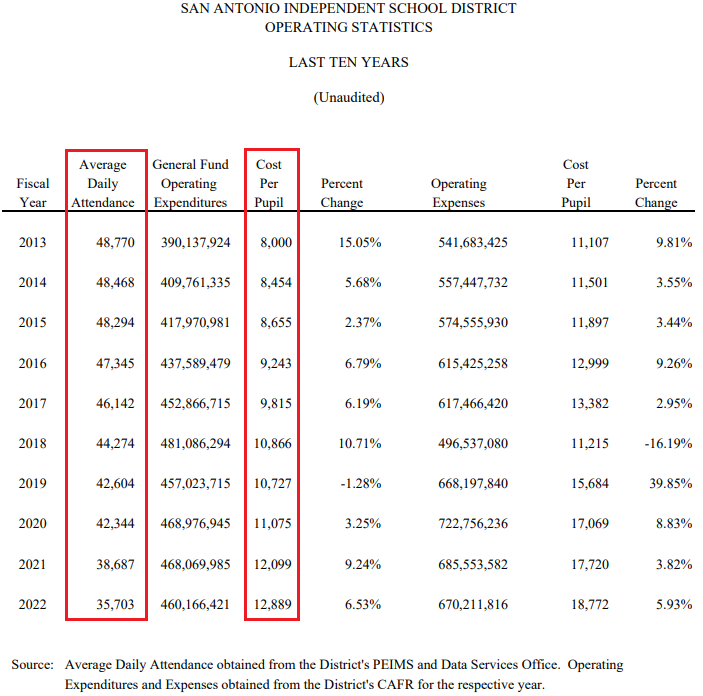Earlier this week, San Antonio ISD officials complained that “tough decisions” lie ahead as budget deliberations began in earnest. Some even lamented that, absent drastic action, SAISD would be forced into “cutting hundreds of staff positions” across the district. The source of district’s budget woes, according to the superintendent, was three-fold: “stagnant state funding, declining enrollment, and the sunset of pandemic relief funds.”
Curiously, there was no mention of persistent and excessive spending growth, even though a cursory review of the data suggests that it is the root of the problem.
To illustrate the point, consider the district’s spending habits in relation to its student population. From 2013 to 2022, SAISD’s general fund operating expenditures experienced a noticeable growth, rising from $390,137,924 to $460,166,421, according to its latest available Annual Comprehensive Financial Report (ACFR). In per capita terms, the district’s cost per pupil rose from $8,000 per student in 2013 to $12,889 per student in 2022, representing a 61% increase over the 10-year period.
By comparison, the district’s average daily attendance shrank from 48,770 in 2013 to 35,703 in 2022. That’s a roughly 27% decrease in the number of students being educated.

Making matters worse, the district has been misusing federal pandemic aid, such that it has created recurring expenses with one-time monies. Here’s more from San Antonio Report:
“Over the last three years, the district has received $100 million in funding from the federal government to help with COVID-related costs. Those funds expire this year…With the COVID relief funds, the district created hundreds of positions to support social-emotional development, mental health and college, career and military readiness along with positions focused on learning loss. While the district’s general funds will now pay some of those employees, other positions are being eliminated as the funds expire, according to district spokeswoman Laura Short.” [emphasis mine]
What this reporting suggests is that the district itself bears partial responsibility for the “tough decisions” ahead. After all, it helped create this situation by using temporary aid to fund ongoing commitments.
Even apart from pandemic aid though, the district’s inability to control its general revenue budget is apparent and stands out like a sore thumb when considered in the context of its shrinking student enrollment. Indeed, the data strongly suggests that outside influences, like pandemic aid, are not chiefly to blame, but rather, that systemic issues afflict the district’s finances.
Bottom line: SAISD’s budgetary woes are of its own making. It alone has demonstrated a long pattern of spending excess, failure to retain students, and poor planning. Thus, if there are any budget reductions looming, then they are much needed and long overdue.